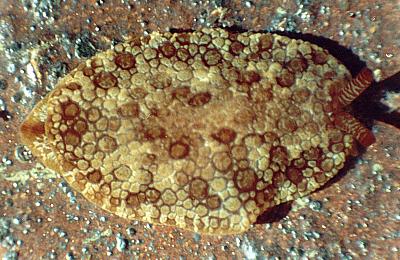
Pleurobranchus areolatus
Mörch, 1863
Order: NOTASPIDEA
Superfamily: PLEUROBRANCHOIDEA
Family: Pleurobranchidae
DISTRIBUTION
West Atlantic - Caribbean to Brazil; possibly east Pacific.
PHOTO
Santa Marta, Colombia [Caribbean coast], 3-5cm long. Photos: Phanor Montoya
For discussion on identity see Phanor Montoya's message below.
Reference:
• Mörch, O.A.L. (1863) Contributions à la Faune malacologique des Antilles danoises. Journal de Conchyliologie, 11: 21-43.
• Thompson, T.E. (1977) Jamaican opisthobranch molluscs I. Journal of Molluscan Studies, 43(2): 93-139, pls.1-3.
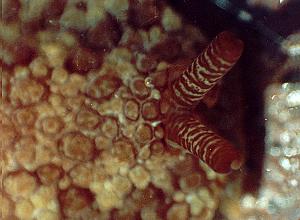
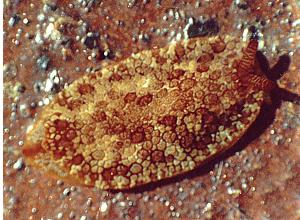
Rudman, W.B., 2000 (October 21) Pleurobranchus areolatus Mörch, 1863. [In] Sea Slug Forum. Australian Museum, Sydney. Available from http://www.seaslugforum.net/find/pleuareo
Related messages
Giant Pleurobranchus areolatus from Cabo Frio, Brazil.
February 15, 2005
From: Vinicius Padula
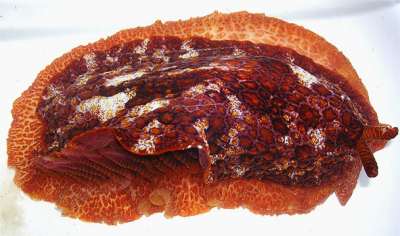
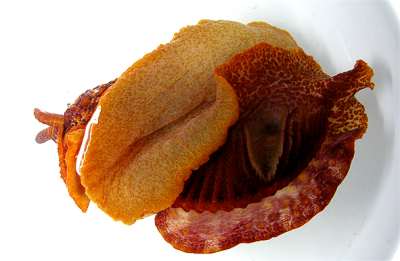
Dear Bill,
I´m impressed with the size of this Pleurobranchus areolatus. It was about 150 mm and was so limp when I took it out of the water.
Locality: Conchas Beach, Rio de Janeiro, Brazil. Depth: 1 m. Length: 150 mm. 6 January 2005. Intertidal. Photographer: Vinicius Padula
This animal was a welcome surprise for me.
Vinicius Padula
viniciuspadula@hotmail.com
Padula, V., 2005 (Feb 15) Giant Pleurobranchus areolatus from Cabo Frio, Brazil.. [Message in] Sea Slug Forum. Australian Museum, Sydney. Available from http://www.seaslugforum.net/find/13151Dear Padula,
!5 cm is a good size for a pleurobranch, certainly larger than the 11 cm one Eveline Marcus reported from Cabo Frio [see message #10922]. I have seen a 30 cm long Pleurobranchus forskalii! - but that species is seldom seen much longer than 10 or 11 cm..
Best wishes,
Bill Rudman
Re: Pleurobranchus areolatus from Brazil
January 25, 2004
From: Fabio Wiggers
I have also recorded Pleurobranchus areolatus from Florianópolis (Reserva Biológica Marinha do Arvoredo), Santa Catarina, southern Brazil in the article:
• Wiggers & Magalhães 2003. Novas ocorrências de moluscos marinhos na reserva biologica marinha do Arvoreso. Biotemas, 16(1): 81-89.
As far as I know it is the southernmost record for the species.
Fabio Wiggers
fwiggers@yahoo.com
Wiggers, F., 2004 (Jan 25) Re: Pleurobranchus areolatus from Brazil. [Message in] Sea Slug Forum. Australian Museum, Sydney. Available from http://www.seaslugforum.net/find/12007Thanks Fabio,
Bill Rudman
Pleurobranchus areolatus from Jamaica
October 20, 2003
From: Ross W. Gundersen

Dear Bill:
Here is another sea slug from Jamaica. As I said in my first message, all specimens were collected from St. Ann's Bay, Jamaica, West Indies. Photo: R. Gundersen.
Here is Pleurobranchus areolatus. Found under coral rock on back reef at 2m.
Best wishes,
Ross
ross.gundersen@uwp.edu
Gundersen, R.W., 2003 (Oct 20) Pleurobranchus areolatus from Jamaica. [Message in] Sea Slug Forum. Australian Museum, Sydney. Available from http://www.seaslugforum.net/find/11132Thanks Ross,
This is definitely what we are calling Pleurobranchus areolatus
Best wishes
Bill Rudman
Re: Pleurobranchus areolatus from Brazil
September 12, 2003
From: Vinicius Anderson
Dear Bill,
Thank you for your reply to my message. This site is extraordinary!
I like so much sea slugs and recently (1 month) I become a trainee at Laboratory of Malacology in UFRJ [Universidade Federal do Rio de Janeiro], Rio de Janeiro. There, the work basic is with taxonomy of small gastropods (Olivellidae, Olividae, Barleeidae...) organized by Dr.Ricardo Absalão. Unfortunately we don´t work with sea slugs at UFRJ. I think Brasil doesn't have any experts on nudibranchs. Do you know of any? Maybe in the future I will be one.
About Pleurobranchus areolatus, Eliézer Rios (1994) and Francisco R. García et al (2002) recorded specimens from Cabo Frio and Fernando de Noronha Island in Brasil respectively. In the García paper its is recorded also from the Pacific [Panama and Galapagos Islands], and in the Atlantic Ocean [from Florida to Canary Islands and Ghana].
• García, F.R., Troncoso, J.S. & Domiguez, M. (2002) New data on benthic Opisthobranch Molluscs from the Archipelago of Fernando de Noronha (Brazil), with description of new species os Aegires Lóven, 1844. Iberus, 20(2): 45-56.
Best regards,
Vinicius Anderson
viniciusanderson@hotmail.com
Anderson, V., 2003 (Sep 12) Re: Pleurobranchus areolatus from Brazil. [Message in] Sea Slug Forum. Australian Museum, Sydney. Available from http://www.seaslugforum.net/find/10942Dear Vinicius,
Any photos and information you can send us on sea slugs from Brazil will be very welcome. For many years [from 1950s to 1970s] Ernst and Eveline Marcus were well known international experts on sea slugs. They were at the University of Sao Paulo, but are now no longer with us. They described quite a few species from Brazil and the Caribbean but seldom illustrated their species very well, and only very rarely in colour. So photographs of your local fauna, even animals you think are common, would be great to include on the Forum as they would help us interpret and better understand the Marcus's species.
Best wishes
Bill Rudman
Brazilian Pleurobranchus areolatus?
September 10, 2003
From: Vinicius Anderson

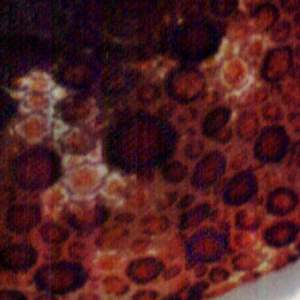
Bill,
I´m a Brazilian student of Biology from Rio de Janeiro - Brasil. Last month, I travelled to Cabo Frio, a city next to Rio. I collected this slug at Conchas Beach in 9 August, on a reef and a depth of approximately 2 meters. I think there is a Pleurobranchus areolatus. What do you think?
Date: August 9 2003
Location: Conchas Beach, Cabo Frio, Rio de Janeiro - Brasil
Depht: 2 meters
Size: ~50mm
The photo is mine.
Thank you,
Vinicius Anderson
viniciusanderson@hotmail.com
Anderson, V., 2003 (Sep 10) Brazilian Pleurobranchus areolatus?. [Message in] Sea Slug Forum. Australian Museum, Sydney. Available from http://www.seaslugforum.net/find/10922Dear Vinicius,
Your animal certainly fits what has been identified as Pleurobranchus areolatus. Unfortunately Mörch's original description was very poor. Your photo is very similar to Thompson's (1977) description of specimens from Jamaica. Eveline Marcus (1976) records an 11cm long specimen from Cabo Frio as P. areolatus and in an earlier paper (Marcus, 1970) had recorded a specimen from Maranhao, in nthn Brazil, [as P. testudinarius], which is almost certainly a misidentification for P. areolatus.
• Marcus, Ev. (1970) Opisthobranchs from northern Brazil. Bulletin of Marine Science, 20: 922-951.
• Marcus, Ev (1976) Marine euthyneuran gastropods from Brazil (3). Studies Neotropical Fauna and Environment, 11(1/2): 5-23.
• Thompson, T.E. (1977) Jamaican opisthobranch molluscs I. Journal of Molluscan Studies, 43(2): 93-139, pls.1-3.
Best wishes,
Bill Rudman
Pleurobranchus species question
September 20, 2002
From: Alicia Hermosillo
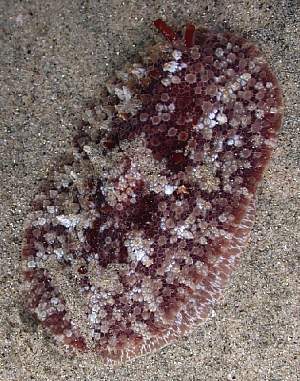
Dear Dr. Rudman,
These series of pictures are of the species I have been calling Pleurobranchus aerolatus. I find them all the time under rocks. The eggs they lay are the typical white eggs of Pleurobranchus sp. It would be very helpful for me to clarify any doubt in the species name.
Upper right: Picture 1: Majahuitas, Bahia de Banderas, Pacific Coast of Mexico, 67mm long, 25 feet deep, July 25th 2002
Lower left: Sayulita, Nayarit, Pacific Coast of Mexico, 54 mm, intertidal, March 17th 2002
Lower right: Mismaloya Beach, Bahia de Banderas, Pacific Coast of Mexico, 12mm, 20 feet deep, April 24th 2002.
Alicia Hermosillo
gueri25@hotmail.com
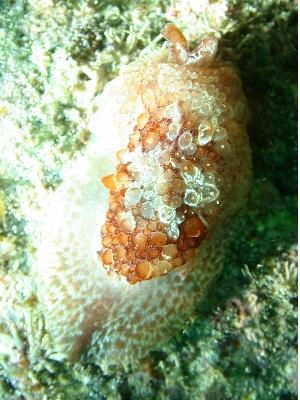
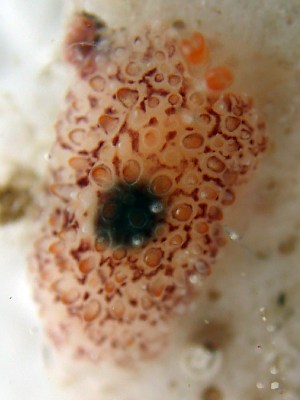
Dear Ali,
Thanks for these photos. It certainly seems to be what others are identifying at present as P. areolatus from the East Pacific. As is discussed in other messages on this page, whether it is actually the same as the Caribbean species can only be determined when the the Caribbean species are better known
Best wishes,
Bill Rudman
Pleurobranchus? from Colombia
September 16, 2001
From: Elianny Dominguez Tejo


Dear Bill,
I guess this is some kind of pleurobranch. You can see the rhinophores up close in the second picture. And also, the dark spot on the dorsal is actually green (dark green).
It is about 1.5 cm long and we found it under a rock, at 10 cm of depth, on the Caribbean coast of Colombia [Santa Marta].
Kind regards,
Elianny Dominguez
elicelotte@latinmail.com
Dominguez Tejo, E., 2001 (Sep 16) Pleurobranchus? from Colombia. [Message in] Sea Slug Forum. Australian Museum, Sydney. Available from http://www.seaslugforum.net/find/5265Dear Elianny,
I am pretty sure this is a juvenile of Pleurobranchus areolatus. Quite a few species of Pleurobranchus have a quite different appearance as juveniles and I suspect this is the case here.
Best wishes,
Bill Rudman
Re: Pleurobranchus from southern California
January 23, 2001
From: Dave Behrens
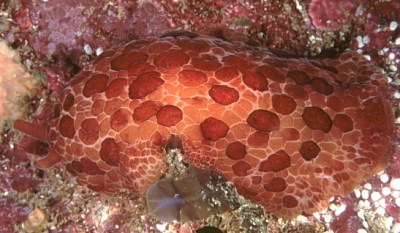
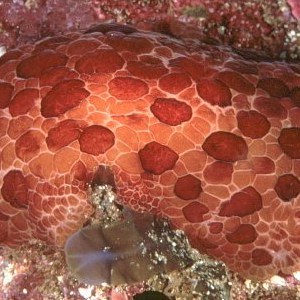
Dear Bill:
This is a critter I have been wrestling with for about 3 years, when it first showed up in the California Channel Islands after El Nino, here. I have received almost a dozen inquiries about its identity from interested Branchers. I have attached a photo of one from San Benitos Island, outer coast of Baja California, Mexico, August 1996. Photo: Eric Haucke of Santa Cruz, California. It was the Week 71 opisthobranch on Mike Miller's Site
Its identification has caused some discussion among our California colleagues. I seem to be odd man out, however. At this time we agree with your ID. Internally the critter is identical to Pleurobranchus areolatus. The major difference and the one that bothers me is the texture and lack of white flecks on the dorsal tubercles.
You might notice that in Briannes's photos and in Eric Haucke's, the tubercles are very low, flat and absolutely smooth, not a white fleck to be found. In typical P. areolatus the tubercles vary in height and have a central point (not easily seen in Phanor's photos), and always are covered with white flecks and encrustations.
In any event, just last week Terry Gosliner told me that we soon will have the answer. One of his student's has received a grant to look at genetic similarities/differences of species living on both sides of the Panama Isthmus. Pleurobranchus areolatus is to be included in this effort. We have
collected typical Pleurobranchus areolatus material from the Caribbean and Pacific side, and have tissue from the animal Brianne shares here. The three will be compared. I am looking forward to the results.
Dave Behrens
Dave@seachallengers.com
Behrens, D. , 2001 (Jan 23) Re: Pleurobranchus from southern California. [Message in] Sea Slug Forum. Australian Museum, Sydney. Available from http://www.seaslugforum.net/find/3596Dear Dave,
I think the problem may be more complicated than it appears on the surface. As I mentioned when discussing Phanor's message there seems to be a problem in determining just what is "typical' P. areolatus. The original description didn't give too many clues. Phanor also sent photos of a second species from the Caribbean coast which look to be very like the Indo-West Pacific Pleurobranchus albiguttatus. Are its white markings what you are suggesting is typical of Caribbean P. areolatus? This is the species Humann identifies as P. areolatus.
In brief there seem to be three obvious questions. Firstly how many species of Pleurobranchus occur in the Caribbean? Secondly, if there is more than one, which is P. areolatus? And thirdly, do any of them, also occur on the Pacific side of the isthmus?
Cheers,
Bill Rudman
Pleurobranchus from southern California
January 20, 2001
From: Brianne Berlin


This critter was found in 35 feet of water over rocky / rubble substrate
Temp.= 55 F
Catalina Island, southern California.
I have never seen anything like it. Any info would be helpful.
Thank you
Brianne
bberlin@guideddiscoveries.org
Berlin, B., 2001 (Jan 20) Pleurobranchus from southern California. [Message in] Sea Slug Forum. Australian Museum, Sydney. Available from http://www.seaslugforum.net/find/3565Dear Brianne,
This is really one for the Californian crowd to comment on but I think it is Pleurobranchus areolatus, a relatively large pleurobranch, growing to about 15cm, which is found in the Caribbean and on the Pacific coast of central America. I didn't know it was found as far north as California.
Pleurobranchus areolatus is one of those interesting species with populations on both sides of the Panama Isthmus which have been separated from each other since the isthmus formed in the Tertiary. You will see a photo of an animal from the Caribbean coast of Bolivia in an earlier message from Phanor Montoya.
Best wishes,
Bill Rudman.
Notaspids from Colombia
October 22, 2000
From: Phanor Montoya

Dear Bill:
I have found two species of notaspid. [Santa Marta, Colombia - Caribbean coast] They were collected in a bivalve larvae net collector. They were 3-5 cm long. I think they belong to the genus Pleurobranchus but I'm not sure. What do you think? I have sent photos of the other species in a separate message.
Sincerely yours,
Phanor Montoya
phamont@eudoramail.com


Dear Phanor,
Thanks for the interesting photos of the two pleurobranchs. Like many Caribbean opisthobranchs, there is still some problems in identifying species from your region. The biggest problem being that the original descriptions were not very detailed and there were no accompanying illustrations. Later workers may have compounded the problem by misidentifying these earlier names. There is no easy way to be sure but I think these photos are of Pleurobranchus areolatus Moerch, 1863. I have reached that conclusion, not because there are any characters positively identifying it with Moerch's original description but because chracters found in two other species from the Caribbean are absent from Moerch's description of P. areolatus. In particular, the Mediterranean Pleurobranchus testudinarius is recorded f rom the Caribbean but has large pointed tubercles. The other distinctive species I have seen photos of from the Caribbean is the animal in your second message which is characterised by the white triangular makes on some tubercles.
So I can't be sure that this is P. areolatus, but I am not sure we are ever going to be sure just what Moerch's species was.
Best wishes,
Bill Rudman.
